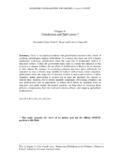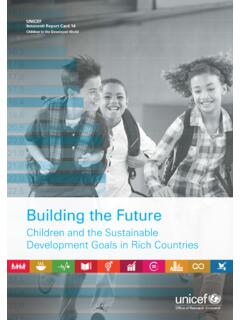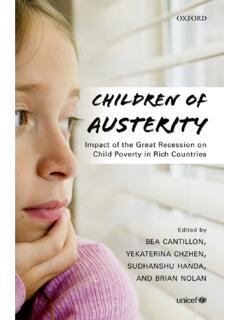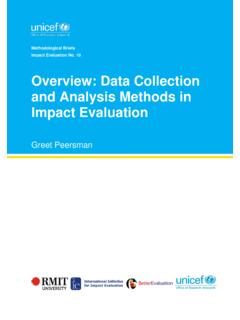Transcription of The Adolescent Brain: A second window of opportunity
1 The Adolescent Brain: A second window of opportunityA CompendiumThe Office of Research Innocenti is UNICEF s dedicated research centre. It undertakes research on emerging and current issues in order to inform the strategic directions, policies and programmes of UNICEF and its partners, shape global debates on child rights and development, and inform the global research and policy agenda for all children, and particularly for the most produced by the Office are contributions to a global debate on children and may not necessarily reflect UNICEF policies or approaches . The views expressed are those of the Office of Research Innocenti receives financial support from the Government of Italy, while funding for specific projects is also provided by other governments, international institutions and private sources, including UNICEF National part of this publication may be freely reproduced using the following reference:UNICEF Office of Research - Innocenti (2017).
2 The Adolescent Brain: A second window of opportunity , UNICEF Office of Research - Innocenti, Florence. 2017 United Nations Children s Fund (UNICEF)UNICEF Office of Research InnocentiPiazza SS. Annunziata, 1250122 Florence, ItalyTel: (+39) 055 20 330 Fax: (+39) 055 2033 978 88 6522 048 1 Front cover: Todd SilerBelow the Clouds of Consciousness, 1989 Courtesy Ronald Feldman Fine Arts, New York ACKNOWLEDGEMENTSThis compendium was edited by Nikola Balvin (Knowledge Management Specialist, Innocenti) and Prerna Banati (Chief, Programme and Planning, Innocenti). Productionwas overseen by Eve Leckey (Publications Assistant, Innocenti) and Sarah Marchant (Editorial Assistant, Innocenti). Graphic design was by Mannocchi Design, Rome.
3 UNICEF is most grateful to the authors for their contributions to this innovative project. Sarah Cook, Director of the Office of Research - Innocenti, and Ted Chaiban, Programme Director, New York, provided helpful comments and go to Judith Diers, Chief of the Adolescent Development and Participation Section, UNICEF New York, who spearheaded the consultation from which these contributions are is most grateful to Todd Siler and to Ronald Feldman Fine Arts, New York for the rights to use the works of art reproduced in this Siler, PhD, is an American multimedia artist, author, educator, and inventor, equally well known for his art and for his work in creativity research. He describes his philosophy as Realizing human potential.
4 That s my life s work. Those three words sum up everything I live for and aspire to accomplish through my art. Many of his works are inspired by the brain and its functioning and his interest in its power and flexibility. COVERTodd SilerBelow the Clouds of Consciousness, 1989 Mixed media on paper4 x 12 ftCourtesy Ronald Feldman Fine Arts, New YorkPages 6-7 Todd SilerCrossing the Primordial Bridges between Art Science Technology in Human Nervous Systems, 1989 Courtesy Ronald Feldman Fine Arts, New YorkPages 18-19 Todd SilerWhat Are All the Dimensions of Consciousness? 1988-1989 Courtesy Ronald Feldman Fine Arts, New YorkPages 26-27 Todd Siler Humanature A Turbulent Integration, 1991 Courtesy Ronald Feldman Fine Arts, New YorkPages 36-37 Todd SilerEvolution of Abstract Realism, 2010-2011 Mixed media on paper22 x 35 inchesPhoto: Bill OrcuttCourtesy Ronald Feldman Fine Arts, New YorkPages 46-47 Todd SilerMind Icon (Metaphorming Conscience), 1991 Multi-colored serigraph on Arches 300gm paper40 x 60 cmCourtesy of Ronald Feldman Fine Arts, New YorkPages 54-55 Todd SilerMetaphorming Civilizations, 1992-1993 Courtesy of Ronald Feldman Fine Arts, New YorkPages 62-63 Todd Siler Metaphorming Humanature.
5 Humankind s Integration with Nature, 1989 Courtesy of Ronald Feldman Fine Arts, New YorkPages 72-73 Todd SilerEnvisioning a Cornucopia of All-purpose Nanomaterials (2014) Mixed media on synthetic canvas6 x 12 ftCourtesy of Ronald Feldman Fine Arts, New YorkPages 80-81 Mind Icon (Questioning Our Evolution), 1991 Multi-colored serigraph on Arches 300gm paper40 x 60 cmCourtesy of Ronald Feldman Fine Arts, New York CONTENTSF oreword Introduction 9 Adolescent Brain Development: Windows of opportunity 21 Ron Dahl and Ahna Suleiman Neuroimaging and the Adolescent Brain: A period of plasticity for vulnerabilities and opportunities 29 Beatriz Luna Situating the Adolescent Brain: The developing brain in its cultural contexts 39 Suparna Choudhury Poverty and the Adolescent Brain 49 Kimberly NobleHelping Teenagers Develop Resilience in the Face of Stress 57 Sonia J.
6 LupienUnderstanding Adolescent Neuroplasticity: A guide to developing resiliency programmes for adolescents 65 Elizabeth Ward Mindfulness Meditation Impact on the Adolescent Brain 75Yi-Yuan TangThe Perils and Promise of Technology for the Adolescent Brain 83 Melina R. Uncapher The Adolescent Brain: A second window of opportunityTHE Adolescent BRAIN: A second window OF OPPORTUNITYA Compendium FOREWORDUNICEF Executive Director, Anthony LakeFew things irritate adolescents more than being told what to do or how to think. Their need for independence is not only emotional. Adolescence is a critical developmental phase of life, a time during which children acquire the social skills they need to thrive as adults. Just as critically, it is also the time in which their brains develop or fail to develop in a way that enables them to reach their full potential in life.
7 We already know that in the earliest years of childhood, children s brains form neural connections at a rate never to be repeated. This is the first window of opportunity to influence the development of children s brains through nutrition, stimulation and protection from violence and other a growing body of scientific knowledge shows that experience and environment also combine with genetics to shape the brains of adolescents. This presents a second , crucially important window of opportunity to influence the development of children s brains and thus, their futures. In 2016, UNICEF hosted The Adolescent Brain: A second window of opportunity , a symposium that brought together experts in Adolescent neuroscience to discuss this emerging science and how we can apply it to support all adolescents but especially those already facing risks to their well-being, including poverty, deprivation, conflict and crisis.
8 The articles in this compendium elaborate on some of the ideas shared at the symposium. Together, they provide a broad view of the dynamic interactions among physical, sexual and brain development that take place during adolescence. They highlight some of the risks to optimal development including toxic stress, which can Forewordinterfere with the formation of brain connections, and other vulnerabilities unique to the onset of puberty and independence. They also point to the opportunities for developing interventions that can build on earlier investments in child development consolidating gains and even offsetting the effects of deficits and traumas experienced earlier in childhood. Evidence shows that practical approaches including safe and secure environments, or the presence of a caring adult can help counteract the effects of trauma and lay a better foundation for optimal development.
9 The symposium also highlighted the importance of greater collaboration between the scientific research community and development professionals to develop and implement policies and programmes that apply the new science something we at UNICEF will explore more concretely with partners in the months and years billion adolescents in the world today, all of us have a stake in helping them to reach their full potential. For today s independence-seeking Adolescent is tomorrow s doctor. Tomorrow s teacher. Tomorrow s worker. Tomorrow s leader. Their future is the future of our world. Anthony Lake Executive Director, UNICEFINTRODUCTIONC rossing the Primordial Bridges between Art Science Technology in Human Nervous Systems (1989)9 INTRODUCTION Scientific advances over the past decade have contributed to a much greater understanding of the growth of the human brain from birth to adulthood.
10 Latest evidence illuminates the Adolescent brain as a work in progress , and adolescence as a critical period to build on early investments, offering a second chance for those who have not fared well in early childhood. Neuroscientific research in particular is integral to improving our understanding of the cerebral transformations that take place during this time and how they are influenced by interactions between the evolving Adolescent brain and the environment in which it develops. In the field of early childhood development (ECD), neuroscientific evidence featured prominently in galvanizing positive change for children through changes in policy and programming and more of this type of evidence is needed to also provide answers regarding critical intervention junctures and approaches during adolescence.









